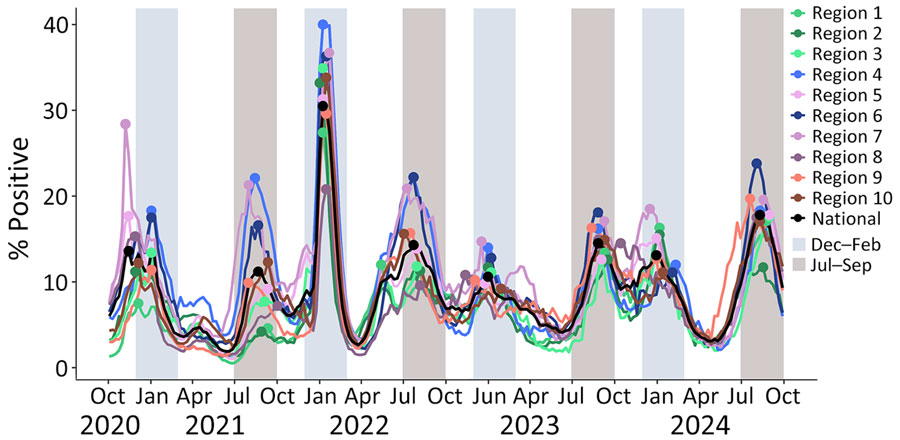Volume 31, Number 8—August 2025
Research
Estimated COVID-19 Periodicity and Correlation with SARS-CoV-2 Spike Protein S1 Antigenic Diversity, United States
Figure 1

Figure 1. Weekly smoothed (3-week) percentages of positive SARS-CoV-2 tests reported to the National Respiratory and Enteric Surveillance System (NREVSS), nationally and by Health and Human Services (HHS) Region, United States, October 2020–September 2024. The data represent SARS-CoV-2 nucleic acid amplification test results, which include reverse transcription PCR tests from the NREVSS sentinel network of laboratories in the United States, including clinical, public health, and commercial laboratories. These data exclude antigen, antibody, and at-home test results. Blue (December–February) and gray (July–September) vertical bands indicate time periods with increased percentage positivity. Seasonal peaks are indicated by dots at the week when smoothed percent positivity peaked. Regional colors are grouped by geography (e.g., Regions 1, 2, and 3 are shades of green and comprise the Northeast). All HHS Regions had 2 seasonal peaks a year, except HHS Region 8, which only had 1 peak between summer 2023 and winter 2023–2024. HHS Region 1: Connecticut, Maine, Massachusetts, New Hampshire, Rhode Island, and Vermont; HHS Region 2: New Jersey, New York, Puerto Rico, and the Virgin Islands; HHS Region 3: Delaware, District of Columbia, Maryland, Pennsylvania, Virginia, and West Virginia; HHS Region 4: Alabama, Florida, Georgia, Kentucky, Mississippi, North Carolina, South Carolina, and Tennessee; HHS Region 5: Illinois, Indiana, Michigan, Minnesota, Ohio, and Wisconsin; HHS Region 6: Arkansas, Louisiana, New Mexico, Oklahoma, and Texas; HHS Region 7: Iowa, Kansas, Missouri, and Nebraska; HHS Region 8: Colorado, Montana, North Dakota, South Dakota, Utah, and Wyoming; HHS Region 9: Arizona, California, Hawaii, Nevada, American Samoa, Commonwealth of the Northern Mariana Islands, Federated States of Micronesia, Guam, Marshall Islands, and Republic of Palau; HHS Region 10: Alaska, Idaho, Oregon, and Washington. Data from US-affiliated Pacific Islands are not included in NREVSS.